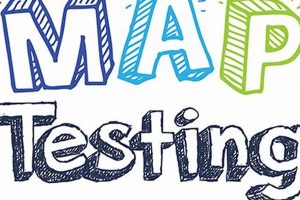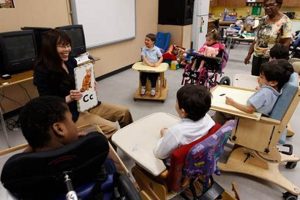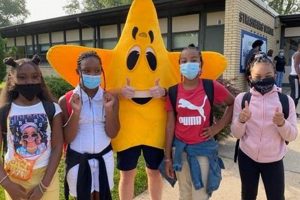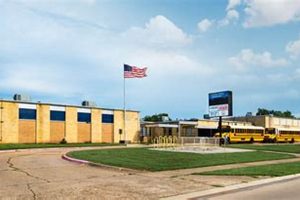Exceptional educational settings for students with Individualized Education Programs (IEPs) prioritize individualized instruction, specialized support services, and inclusive learning environments. These schools often feature smaller class sizes, highly trained special education teachers, and therapists, and utilize evidence-based interventions tailored to each student’s unique needs. An example might include a school with a dedicated sensory room for students with sensory processing challenges or a robust assistive technology program.
Providing appropriate educational services for students with IEPs is crucial for their academic, social, and emotional development. Effective programs can significantly improve learning outcomes, foster independence, and build self-esteem. Historically, students with disabilities were often excluded from mainstream education. The development of IEPs and the movement toward inclusive practices represent significant progress in ensuring that all students have access to a quality education that meets their individual needs.
Understanding the characteristics of effective programs and how to identify them is essential for parents and educators. This discussion will delve into key factors to consider when evaluating educational options for students with IEPs, including curriculum modifications, assessment strategies, and collaborative partnerships between school staff and families.
Tips for Selecting Optimal Educational Environments for Students with IEPs
Choosing the right educational setting is crucial for students with IEPs. The following tips offer guidance for navigating this important decision.
Tip 1: Thoroughly Review the IEP: Carefully examine the student’s IEP to understand their specific learning needs, goals, and required services. This document serves as a roadmap for educational planning.
Tip 2: Evaluate School Resources and Support Services: Investigate the availability of specialized resources, such as assistive technology, adaptive equipment, and therapeutic services (e.g., occupational therapy, speech therapy). Determine if the school has qualified staff to deliver these services effectively.
Tip 3: Consider Class Size and Student-Teacher Ratio: Smaller class sizes and lower student-teacher ratios can provide more individualized attention and support for students with IEPs.
Tip 4: Assess the School’s Commitment to Inclusion: Look for schools that embrace inclusive practices and foster a welcoming and supportive environment for all students. Observe classroom interactions and school-wide activities to gauge the level of inclusion.
Tip 5: Inquire About Teacher Training and Professional Development: Determine if teachers receive ongoing training in special education best practices, including differentiated instruction, behavior management, and IEP implementation.
Tip 6: Communicate with School Staff and Parents: Schedule meetings with the school’s special education team, classroom teachers, and administrators to discuss the student’s needs and the school’s ability to meet them. Connect with other parents of students with IEPs to gather their perspectives and experiences.
Tip 7: Visit the School and Observe Classrooms: A school visit provides valuable firsthand insight into the learning environment. Observe classroom dynamics, student engagement, and the overall atmosphere of the school.
By carefully considering these factors, parents and educators can make informed decisions that contribute to the academic success and overall well-being of students with IEPs.
Ultimately, selecting the best educational setting involves a comprehensive evaluation of the student’s individual needs, the school’s resources, and the collaborative partnership between families and educators.
1. Individualized Instruction
Individualized instruction forms the cornerstone of effective education for students with IEPs. In the context of elementary schools, it signifies tailoring teaching methods, materials, and learning environments to meet the unique needs of each student, as outlined in their IEP. This approach recognizes that students learn at different paces and in diverse ways, necessitating customized support to maximize their potential.
- Differentiated Instruction:
Differentiated instruction involves modifying the content, process, product, or learning environment based on student readiness, interests, and learning profiles. For example, a student with dyslexia might benefit from audiobooks and assistive technology, while a student with ADHD might require frequent movement breaks and alternative seating arrangements. Effective differentiation ensures all students access the curriculum and achieve meaningful learning outcomes.
- Targeted Interventions:
IEPs often specify targeted interventions to address specific learning challenges. These interventions may include specialized reading programs, one-on-one tutoring, or behavioral support strategies. For instance, a student struggling with math may receive intensive instruction in specific math skills through a research-based intervention program. Regular progress monitoring ensures the effectiveness of these interventions and allows for adjustments as needed.
- Adaptive Learning Technologies:
Adaptive learning technologies leverage software and digital platforms to personalize learning experiences. These tools adjust the difficulty level and content based on student performance, providing customized feedback and support. Examples include educational apps that provide personalized practice in reading or math and software programs that offer text-to-speech and other accessibility features. Such technology can enhance individualized instruction by providing targeted practice and individualized feedback.
- Collaboration and Communication:
Effective individualized instruction requires ongoing collaboration and communication between teachers, special education staff, parents, and the student. Regular communication ensures everyone is informed about the student’s progress, challenges, and adjustments to the instructional plan. Collaborative team meetings and parent-teacher conferences provide opportunities to discuss the student’s IEP goals, learning strategies, and progress toward achieving those goals.
These facets of individualized instruction contribute significantly to the success of students with IEPs in elementary school settings. By tailoring educational experiences to individual needs and strengths, schools create an environment where all students can thrive academically, socially, and emotionally. The synergy of these components ensures that students receive the appropriate level of support and challenge, fostering a sense of accomplishment and preparing them for future academic success.
2. Specialized Support Services
Specialized support services constitute a critical component of effective educational programs for students with IEPs. These services address specific learning, developmental, and behavioral needs that cannot be fully met through general education alone. The availability and quality of these services significantly impact a school’s ability to provide a truly inclusive and supportive learning environment.
Examples of specialized support services include speech-language therapy, occupational therapy, physical therapy, assistive technology support, and counseling services. These services may be provided individually or in small groups, depending on the student’s needs and IEP goals. For instance, a student with a speech impediment might receive individual speech therapy sessions to improve articulation skills, while a student with autism might benefit from occupational therapy to develop social skills and sensory regulation strategies. The integration of these services within the school day ensures consistent support and maximizes opportunities for learning and growth. Access to assistive technology, such as text-to-speech software or adaptive keyboards, can further enhance learning and promote independence for students with diverse learning needs.
The presence of comprehensive specialized support services distinguishes high-quality programs for students with IEPs. Schools that prioritize these services demonstrate a commitment to meeting the individual needs of all learners and fostering an inclusive educational environment. The lack of adequate support services can hinder a student’s progress and limit their ability to reach their full potential. Therefore, careful consideration of the availability, quality, and accessibility of specialized support is essential when evaluating educational options for students with IEPs. Effective implementation of specialized support services requires collaboration among educators, therapists, parents, and students. This collaborative approach ensures that services are aligned with the student’s IEP goals and are integrated seamlessly into their overall educational experience.
3. Inclusive Learning Environment
An inclusive learning environment represents a cornerstone of effective education for students with IEPs. In the context of elementary schools, it signifies a commitment to creating a welcoming and supportive atmosphere where all students, regardless of their learning differences, feel a sense of belonging and can actively participate in the learning process. This approach fosters a culture of respect, understanding, and acceptance, promoting social-emotional growth alongside academic achievement. The presence of a truly inclusive learning environment distinguishes exceptional elementary schools for students with IEPs.
- Differentiated Instruction and Assessment:
Inclusive classrooms employ differentiated instruction to accommodate diverse learning styles and needs. This may involve providing materials at varying reading levels, offering multiple means of demonstrating understanding, and using a variety of instructional strategies. Assessments are also differentiated to accurately measure student progress based on their individual learning goals. For example, a student with dysgraphia might be allowed to dictate answers orally instead of writing them. This multifaceted approach ensures all students have equitable access to the curriculum and can demonstrate their learning in ways that best suit their abilities.
- Universal Design for Learning (UDL):
The principles of UDL guide the development of flexible learning environments that can accommodate a wide range of learner variability. UDL emphasizes providing multiple means of representation (how information is presented), action and expression (how students demonstrate their learning), and engagement (how students are motivated to learn). Examples include providing captions for videos, offering flexible seating options, and incorporating student choice in assignments. UDL principles ensure that the learning environment is accessible and engaging for all students, including those with IEPs.
- Collaborative Partnerships:
Strong partnerships between teachers, special education staff, parents, and students are essential for fostering inclusion. Regular communication, collaborative planning, and shared decision-making ensure that everyone is working together to support the student’s success. Parent involvement is particularly crucial, as parents provide valuable insights into their child’s strengths, challenges, and learning preferences. These partnerships create a cohesive support system that empowers students to thrive academically and socially.
- Positive Behavior Interventions and Supports (PBIS):
PBIS is a proactive framework that focuses on teaching and reinforcing positive behaviors and preventing challenging behaviors. Schools that implement PBIS create a positive and predictable learning environment where all students feel safe and respected. This framework emphasizes teaching social-emotional skills, providing positive reinforcement for appropriate behavior, and developing individualized behavior support plans for students who need them. PBIS contributes to a more inclusive learning environment by addressing the social and emotional needs of all students, including those with IEPs.
These interconnected facets of inclusive learning environments collectively create a supportive and enriching educational experience for students with IEPs. Schools that prioritize these elements are best equipped to meet the diverse needs of all learners and foster a sense of belonging and academic success. The synergy between differentiated instruction, UDL principles, collaborative partnerships, and PBIS creates a dynamic and responsive learning environment where students with IEPs can thrive alongside their peers. This holistic approach to inclusion benefits not only students with IEPs but also the entire school community by fostering a culture of empathy, understanding, and respect for individual differences.
4. Collaborative Partnerships
Collaborative partnerships form an essential foundation for elementary schools effectively serving students with Individualized Education Programs (IEPs). These partnerships, encompassing parents, educators, administrators, related service providers (such as speech-language pathologists and occupational therapists), and the students themselves, create a cohesive network of support crucial for maximizing student success. Open communication, shared decision-making, and mutual respect characterize effective collaborative partnerships. This integrated approach ensures alignment between the student’s IEP goals, classroom instruction, and specialized support services, leading to more comprehensive and individualized learning experiences. For example, regular communication between a parent and a teacher regarding a student’s progress on IEP goals allows for adjustments in teaching strategies and home support, ensuring consistent reinforcement. When therapists, educators, and parents work together, they create a synergistic support system that strengthens the effectiveness of interventions and promotes generalized skill development.
The practical significance of collaborative partnerships extends beyond improved academic outcomes. These partnerships foster a sense of community and shared responsibility for student success. Parents feel empowered to actively participate in their child’s education, contributing valuable insights and expertise. Educators benefit from the perspectives of other professionals, leading to more informed instructional decisions and personalized support strategies. Furthermore, collaborative partnerships can facilitate the smooth transition between school and home environments, ensuring consistent application of behavioral strategies and learning supports. For example, if a student struggles with transitions, a collaborative team might develop a consistent visual schedule used both at school and at home, promoting predictability and reducing anxiety. This unified approach creates a more stable and supportive learning environment for the student, maximizing their potential for growth and development.
Effective collaborative partnerships, though demanding dedicated effort and consistent communication, prove invaluable in creating optimal learning experiences for students with IEPs. Challenges such as scheduling conflicts, differing communication styles, and varying perspectives require proactive strategies for conflict resolution and consensus building. However, the resulting benefits improved student outcomes, increased parent engagement, and a stronger sense of community far outweigh the challenges. Ultimately, prioritizing collaborative partnerships distinguishes exemplary elementary schools serving students with IEPs, signifying a commitment to individualized support, holistic development, and shared responsibility for student success.
5. Qualified Educators
The quality of education provided to students with Individualized Education Programs (IEPs) hinges significantly on the expertise and dedication of qualified educators. In the context of elementary schools, “qualified” extends beyond standard teaching certifications to encompass specialized knowledge, skills, and dispositions essential for effectively supporting students with diverse learning needs. This specialized training equips educators to implement individualized instruction, manage diverse learning styles, collaborate effectively with support staff and parents, and foster inclusive learning environments. The presence of highly qualified educators is a hallmark of leading elementary schools serving students with IEPs.
- Specialized Training in Special Education:
Teachers working with students with IEPs benefit significantly from specialized training in special education pedagogy, assessment, and IEP development and implementation. This training provides them with the knowledge and skills to differentiate instruction, adapt curriculum, implement evidence-based interventions, and monitor student progress effectively. For instance, a teacher trained in multi-sensory reading instruction can effectively support a student with dyslexia using techniques that address their specific learning needs. This targeted expertise translates to improved learning outcomes and increased student engagement. Moreover, specialized training prepares educators to collaborate effectively with special education specialists, therapists, and parents, ensuring a cohesive and individualized approach to student support.
- Experience with Diverse Learning Needs:
Practical experience working with students with diverse learning needs is invaluable for educators in inclusive settings. This experience fosters an understanding of how various disabilities impact learning and allows teachers to develop a repertoire of effective teaching strategies. For example, an experienced teacher can anticipate and address the challenges faced by a student with autism spectrum disorder during transitions or group activities, proactively implementing strategies to support their successful participation. Experience also cultivates the ability to differentiate instruction effectively, meeting the individual needs of a diverse group of learners within the same classroom. This adaptability is crucial in inclusive settings where students with IEPs learn alongside their non-disabled peers.
- Collaboration and Communication Skills:
Effective collaboration and communication are indispensable skills for educators working with students with IEPs. These skills facilitate productive partnerships with parents, therapists, special education staff, and administrators, ensuring a coordinated and comprehensive approach to student support. For example, a teacher who effectively communicates with a speech-language pathologist about a student’s communication goals can reinforce those goals within the classroom setting, maximizing the impact of therapy. Strong communication skills also enable educators to advocate for their students’ needs, ensuring they receive the appropriate resources and support to succeed academically and socially.
- Commitment to Inclusive Practices:
A genuine commitment to inclusive practices is essential for educators working with students with IEPs. This commitment manifests in a belief that all students belong and can learn, coupled with a willingness to create a welcoming and supportive learning environment. Educators who embrace inclusion proactively seek professional development opportunities to enhance their understanding of diverse learning needs and inclusive pedagogy. They actively participate in IEP development and implementation, ensuring that students with IEPs are fully integrated into the classroom community. This commitment fosters a sense of belonging and promotes positive social-emotional development for all students.
The presence of qualified educators, possessing these key attributes, is a defining characteristic of exceptional elementary schools serving students with IEPs. These educators create learning environments where individualized instruction, specialized support, and collaborative partnerships converge to maximize student potential. Ultimately, investing in and supporting qualified educators is an investment in the future success of students with IEPs.
6. Accessible Facilities
Accessible facilities are integral to “best elementary schools for students with IEPs,” ensuring equitable access to education and fostering a truly inclusive environment. These facilities go beyond simply meeting legal requirements; they proactively address the diverse needs of students with disabilities, promoting independence, participation, and a sense of belonging. A comprehensive approach to accessibility encompasses physical adaptations, assistive technologies, and considerations for sensory sensitivities, creating a barrier-free learning experience for all.
- Physical Accessibility:
Ramps, elevators, accessible restrooms, and widened doorways are essential physical adaptations that allow students with mobility impairments to navigate the school environment independently. Adjustable desks and chairs accommodate varying physical needs and promote ergonomic positioning for all students. Accessible playgrounds and recreational areas ensure that students with disabilities can participate fully in social and physical activities. These adaptations not only facilitate physical access but also contribute to a sense of inclusion and belonging.
- Assistive Technologies:
Assistive technologies play a vital role in providing equitable access to the curriculum and learning activities. Computers with screen readers, text-to-speech software, and alternative input devices empower students with visual or learning disabilities to access information and express themselves effectively. Augmentative and alternative communication (AAC) devices support students with communication challenges, enabling them to participate actively in classroom discussions and social interactions. The availability and effective integration of assistive technologies demonstrate a school’s commitment to providing individualized support and maximizing learning opportunities for all students.
- Sensory Considerations:
Creating a sensory-friendly environment is crucial for students with sensory processing sensitivities, such as those with autism spectrum disorder. Designated quiet spaces provide a refuge for students who become overstimulated, allowing them to regulate their sensory input and return to the classroom when ready. Sound-absorbing materials in classrooms and hallways minimize distracting noises, creating a calmer learning environment for all students. Adjustable lighting options cater to varying light sensitivities, reducing visual distractions and promoting focus. These sensory considerations demonstrate an understanding of the diverse sensory needs of students and contribute to a more inclusive and supportive learning environment.
- Accessibility of Information and Communication:
Ensuring accessibility of information and communication is paramount for students with IEPs. Providing materials in alternative formats, such as Braille or large print, ensures that students with visual impairments have equal access to learning materials. Closed captioning on videos and the use of sign language interpreters facilitate access to auditory information for students with hearing impairments. Accessible websites and online platforms ensure that all students can access school-related information and resources. These measures demonstrate a commitment to equitable access to information and communication, fostering inclusivity and promoting student success.
In summary, accessible facilities are not merely a checklist of accommodations; they represent a fundamental commitment to creating an inclusive and equitable learning environment for students with IEPs. These features demonstrate a school’s dedication to providing all students with the necessary supports to thrive academically, socially, and emotionally. By proactively addressing accessibility, elementary schools create a foundation for student success, fostering a sense of belonging and empowering students with IEPs to reach their full potential. Truly “best” elementary schools recognize that accessible facilities are not just about compliance but about creating a welcoming and empowering learning environment for all.
Frequently Asked Questions about Choosing the Right Elementary School for Students with IEPs
Selecting an elementary school for a child with an Individualized Education Program (IEP) is a significant decision. This FAQ addresses common concerns and provides information to assist families in making informed choices.
Question 1: How can parents determine if a school truly offers an inclusive environment for students with IEPs?
Observing classroom interactions, reviewing school policies regarding inclusion, and speaking with other parents of students with IEPs can offer valuable insights into a school’s commitment to inclusive practices. Look for evidence of differentiated instruction, collaborative teaching approaches, and opportunities for students with IEPs to participate fully in school activities.
Question 2: What role do parents play in the IEP process at the elementary school level?
Parental involvement is crucial throughout the IEP process. Parents are integral members of the IEP team and contribute valuable information about their child’s strengths, needs, and learning preferences. Parents have the right to participate in IEP meetings, provide input on IEP goals and services, and request revisions to the IEP as needed.
Question 3: What are some signs that a school may not be adequately meeting a student’s needs as outlined in their IEP?
Lack of progress toward IEP goals, frequent behavioral challenges, and limited communication from the school regarding the student’s progress may indicate that a school is not effectively implementing the IEP. Parents should address these concerns with the school’s IEP team and seek solutions collaboratively.
Question 4: How can families find information about the special education services offered by different elementary schools?
School websites, district special education departments, and state education agencies often provide information about special education services offered in different schools. Contacting schools directly and scheduling meetings with special education staff is also recommended.
Question 5: What should families consider when evaluating the qualifications of special education staff at an elementary school?
Inquire about specialized training, certifications, and experience working with students with similar learning needs. Observe classroom interactions and assess the staff’s ability to differentiate instruction, implement behavior management strategies, and utilize assistive technologies effectively.
Question 6: How can parents advocate for their child’s needs if they encounter challenges with the IEP process or implementation?
Open communication with the school’s IEP team is essential. Document concerns, suggest solutions, and request IEP meetings as needed. Parents can also seek assistance from parent advocacy organizations or special education attorneys if challenges persist.
Finding the right elementary school for a student with an IEP requires careful consideration and proactive communication. By understanding their rights and responsibilities within the IEP process, parents can effectively advocate for their child’s educational needs and ensure access to a supportive and enriching learning environment.
Beyond these frequently asked questions, further resources and support for navigating the educational landscape for students with IEPs are available.
Optimizing Educational Outcomes
Optimal elementary school environments for students with Individualized Education Programs (IEPs) necessitate a multifaceted approach. Key elements include individualized instruction tailored to specific learning needs, a comprehensive range of specialized support services, a genuinely inclusive learning environment that fosters a sense of belonging, robust collaborative partnerships between parents, educators, and related service providers, highly qualified educators with specialized training and experience, and fully accessible facilities that promote independence and participation. These components work synergistically to create a supportive and enriching educational experience, maximizing opportunities for academic, social, and emotional growth.
The pursuit of excellence in education for students with IEPs requires ongoing evaluation, advocacy, and a commitment to continuous improvement. Effective implementation of IEPs, coupled with proactive collaboration and a focus on individual student strengths, holds the potential to transform educational outcomes and empower students with IEPs to reach their full potential. Continued dedication to these principles is essential for fostering a future where all students have access to high-quality education that meets their unique needs and prepares them for success in life.







